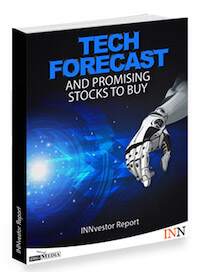Fintech
— short for financial
technology
— has been around for a lot longer than market participants might think. While the term is relatively new, fintech itself can be traced back to the 1860s. So what other fintech facts should investors know?
As
Forbes suggests
, many people often think fintech is more of a recent development. What often comes to mind is a
mobile
app with which a person can make mobile payments for goods and services, removing the need to hold physical currency.
While that is largely true, the first signs of fintech innovation emerged from the invention of the printing press, which allowed for the printing of paper currencies all around the world.
Fast forward to the 1950s, when credit cards were introduced, and then a decade later to the 1960s, when automated teller machines came to the forefront.
A couple of decades later, the 1980s were instrumental for tech advancements in the finance sector, introducing new banking computers and data that allowed for record-keeping systems. The 1990s, of course, brought the emergence of the internet and ecommerce business models.
As can be seen from that quick overview of financial history, fintech has been a growing and evolving market for over a century, and the impact of the fintech industry cannot be overstated. With that in mind, here the Investing News Network briefly breaks down what fintech is and gives an overview of how market participants can invest in the growing fintech market.
Fintech facts: What is fintech?
Technology as a whole is a rapidly growing industry, and the fintech industry has seen innovations related to peer-to-peer lending, real estate, wealth management, personal finance, financial services and more. Fintech companies dedicated to these sectors are popping up more and more.
Still, more people than not are unfamiliar with fintech and fintech solutions. By
Investopedia’s definition
, fintech relates to the ways in which people transact business. Thanks to the evolution of the internet, the term has changed to include any form of advancement in the sector, including retail banking, investing and cryptocurrencies such as bitcoin, which is backed by
blockchain
technology.
Putting it simply, the fintech market has grown so much that it has completely changed how people use physical money. While online banking has been around for quite some time,
digital-only banks
are also making a name for themselves, and payment and mobile banking apps have surged to the forefront. Fintech trends continue to shape consumer behavior within the financial services industry.
For example, a
whitepaper by Infosys
(NYSE:
INFY
) reveals that 64 percent of people prefer to transact via digital-only banks. The firm says that these digital-only banks are the “next wave” in global banking.
Established in 1998, PayPal (NASDAQ:
PYPL
) was one of the first digital payment and money transfer systems. The number of ecommerce payment systems has, of course, expanded since then to include hundreds of companies, such as Square (NYSE:
SQ
), Payline Data, BitPay and Venmo.
In terms of digital-only banks, some examples include popular Canadian players such as Tangerine, a subsidiary of Scotiabank (TSX:
BNS
), and Simplii, a subsidiary of CIBC (TSX:
CM
). In the US, there are Ally (NYSE:
ALLY
) and Finn, a subsidiary of Chase (NYSE:
JPM
). In Asia, the Hong Kong Monetary Authority granted eight digital banking licenses in May 2019 to companies including Tencent Holdings (HKEX:
0700
) and Alibaba (NYSE:
BABA
,OTC Pink:BABAF).
For its part, Australia is experiencing a
rise in neobanks
, also known as smart banks. They operate exclusively online and aren’t associated with any of the country’s major banks. The first neobank to list on the Australian Securities Exchange was Douugh (ASX:
DOU
), which launched
in October 2020
and is
teaming up with
payments company Humm Group (ASX:
HUM
).
Fintech facts: The future of fintech
In 2020, US$44 billion was invested in financial technology, 19 percent higher than 2019,
as per Finextra
. The US accounted for half of that investment, up nearly a third from the previous year.
Most recently, in a preview for the first quarter of 2021,
CB Insights said
that global fintech funding had so far topped US$13.4 billion, the highest quarterly total since 2018’s second quarter. The majority of this funding was spread throughout North America, Europe and Asia.
Many factors are contributing to the fintech market’s success.
Artificial intelligence
(AI), for example, is emerging as an instrumental feature. Mark Cuban, a self-made billionaire,
has said that
faster computer processors and larger data sets may very well push AI “into a wealth of industries and services.”
Fintech investment is also focusing on small businesses. As
Forbes has reported
, there were over 27.9 million small businesses operating in the US in 2019, accounting for close to half of the country’s GDP.
The NASDAQ has gotten in on the fintech action too. In April 2017, the exchange
announced plans
to make minority investments of US$1 million to US$10 million through its NASDAQ Ventures program, with a focus on blockchain, machine learning, AI, data, analytics and content aggregation. It has gone on to invest in companies like
Symbiont
and
PureStream Trading Technologies
.
As a final note, it’s hard not to bring up the impact blockchain technology could have on fintech.
“Blockchain technology offers a secure, fast, and cheaper medium of carrying out online transaction and online transfer of information without the need of third party verification,” a
BIS Research report states
. “The adoption of blockchain technology in financial services sector has gained traction.”
For its part, KPMG believes blockchain has moved beyond the “experimentation” phase, while terming payments and regulatory technology the “most mature” subsectors of fintech. The firm has a strong outlook for the sector as significant funds are set to be injected into various subsectors of fintech.
Fintech facts: Investing in fintech
There are a number of ways for investors to step into the fintech sector, including
exchange-traded funds
(ETFs), which are typically seen as a good way to get broad exposure to a sector. Examples include:
-
Tortoise Digital Payments Infrastructure Fund (CBOE:
TPAY
)
: Started in February 2019,
this ETF
tracks
the Tortoise Global Digital Payments Infrastructure Index. Its top holdings include Square, Fleetcor Technologies (NYSE:
FLT
) and Fidelity National Information Services (NYSE:
FIS
).
-
Global X FinTech Thematic ETF (NASDAQ:
FINX
)
: Launched in September 2016, this ETF is
primarily focused on US companies
and includes 39 holdings. Among its top holdings are Square, Intuit (NASDAQ:
INTU
) and Fidelity National Information Services.
For those who want to invest in specific stocks, there are a number of major fintech players that have not yet been mentioned, including Broadridge Financial Solutions (NYSE:
BR
) and Fiserv (NASDAQ:
FISV
).
There are also options in Canada that investors may want to consider —
click here
for an overview of 12 smaller fintech companies listed on exchanges in the country.
This is an updated version of an article originally published by the Investing News Network in 2017.
Don’t forget to follow us
@INN_Technology
for real-time news updates!
Securities Disclosure: I, Melissa Pistilli, hold no direct investment interest in any company mentioned in this article.








